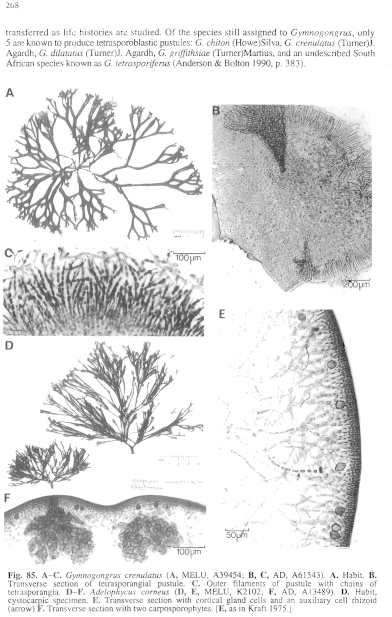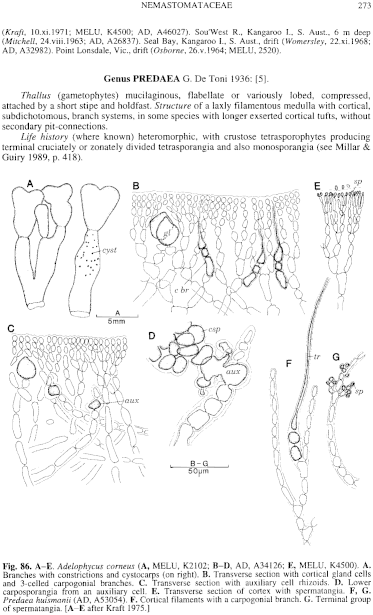|
|
|
|
|
|||||||||||
|
Electronic Flora of South Australia Species Fact Sheet
Phylum Rhodophyta – Class Florideophyceae – Order Gigartinales – Family Nemastomataceae
Synonyms
Adelophyton corneum (J. Agardh) Kraft 1975: 280, figs 1–22.
Chaetangium corneum J.Agardh 1899: 106. Chapman 1969: pl. 12. DeToni 1924: 147.
Thallus (Fig. 85D) dark red-brown, 8–16 cm high, cartilaginous with softer branch tips, much branched subdichotomously at intervals of (2–) 5–10 (–15) mm, branches linear or slightly constricted (Fig. 86A) every 1–3 mm, slightly compressed, 1–2 (–3) mm broad. Holdfast discoid-conical, 1–4 mm across, with a short terete stipe 1–3 mm in diameter; epilithic. Structure multiaxial, developing a moderately dense medulla of entangled filaments and a cortex (Fig. 85E) of more or less anticlinal filaments in discrete branch systems, lax in the inner cortex and becoming compact in the outer cortex where the cells become isodiametric, in 3–5-celled rows, 3–4 µm in diameter; pyriform gland cells prominent in the mid to outer cortex, 12–18 [im in diameter; some inner cortical and outer medullary cells produce rhizoidal filaments. Rhodoplasts discoid, becoming elongate in inner cells.
Reproduction: Sexual thalli dioecious. Carpogonial branches (Fig. 86B) borne on outer ends of inner cortical cells, 3–4 cells long, directed outwards, with a single post-fertilization connecting filament which branches. Auxiliary cells subterminal in long, unbranched rhizoidal filaments (Figs 85E, 86C) borne on outer medullary cells, terminating in the inner cortex. Gonimoblast initial arising from the connecting filament adjacent to the auxiliary cell (Fig. 86D), forming a single (often lobed) cluster of gonimoblast filaments directed mainly inwards, with all cells of the carposporophyte (Fig. 85F) forming subspherical carposporangia 20–25 µm in diameter. Spermatangia (Fig. 86E) cut off from outer cortical cells near branch tips, elongate, producing ovoid spermatia 2–3 µm in diameter.
Tetrasporophytes unknown.
Type from Port Elliot, S. Aust. (Hussey, Feb. 1898); holotype in Herb. Agardh, LD, 32571.
Selected specimens: Cockburn Sound, W. Aust., drift (Kraft, 3.ix.1966; MELU, K2102; AD, A32132). Head of Great Australian Bight, S. Aust., drift (Woelkerling, 3.xi.1968; AD, A34126). Elliston, S. Aust., drift (Womersley, 13.i.1951; AD, A13489). Cape Carnot, S. Aust., in overhung pool (Kraft, 10.xi.1971; MELU, K4500; AD, A46027). Sou'West R., Kangaroo I., S. Aust., 6 m deep (Mitchell, 24.viii.1963; AD, A26837). Seal Bay, Kangaroo I., S. Aust., drift (Womersley, 22.xi.1968; AD, A32982). Point Lonsdale, Vic., drift (Osborne, 26.v.1964; MELU, 2520).
Distribution: Cockburn Sound, W. Aust. to Point Lonsdale, Vic.
References:
AGARDH, J.G. (1899). Analecta Algologica. Cont. V. Acta Univ. lund. 35, 1–160, Plates 1–3.
CHAPMAN, V.J. (1969). The marine algae of New Zealand. Part III: Rhodophyceae. Issue 1: Bangiophycidae and Florideophycidae (Némalionales, Bonnemaisoniales, Gélidiales). (Cramer: Germany.)
KRAFT, G.T. (1975). Consideration of the order Cryptonemiales and the families Nemastomataceae and Furcellariaceae (Gigartinales, Rhodophyta) in light of the morphology of Adelophyton corneum (J. Agardh) gen. et comb. nov. from southern Australia. Br. phycol. J. 10, 279–290.
The Marine Benthic Flora of Southern Australia Part IIIA complete list of references.
Publication:
Womersley, H.B.S. (14 January, 1994)
The Marine Benthic Flora of Southern Australia
Rhodophyta. Part IIIA, Bangiophyceae and Florideophyceae (to Gigartinales)
Reproduced with permission from The Marine Benthic Flora of Southern Australia Part IIIA 1994, by H.B.S. Womersley. Australian Biological Resources Study, Canberra. Copyright Commonwealth of Australia.
Illustrations in Womersley Part IIIA, 1994: FIGS 85 D–F, 86 A–E.

Figure 85 enlarge
Fig. 85. A–C. Gymnogongrus crenulatus (A, MELU, A39454; B, C, AD, A61543). A. Habit. B. Transverse section of tetrasporangial pustule. C. Outer filaments of pustule with chains of tetrasporangia. D–F. Adelophycus corneus (D, E, MELU, K2102; F, AD, A13489). D. Habit, cystocarpic specimen. E. Transverse section with cortical gland cells and an auxiliary cell rhizoid (arrow) F. Transverse section with two carposporophytes. [E, as in Kraft 1975.]

Figure 86 enlarge
Fig. 86. A–E. Adelophycus corneus (A, MELU, K2102; B–D, AD, A34126; E, MELU, K4500). A. Branches with constrictions and cystocarps (on right). B. Transverse section with cortical gland cells and 3-celled carpogonial branches. C. Transverse section with auxiliary cell rhizoids. D. Lower carposporangia from an auxiliary cell. E. Transverse section of cortex with spermatangia. F, G. Predaea huismanii (AD, A53054). F. Cortical filaments with a carpogonial branch. G. Terminal group of spermatangia. [A–E after Kraft 1975.]

|
Email Contact: State Herbarium of South Australia |

|